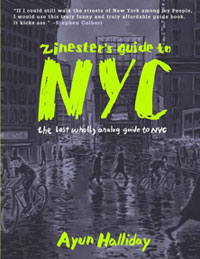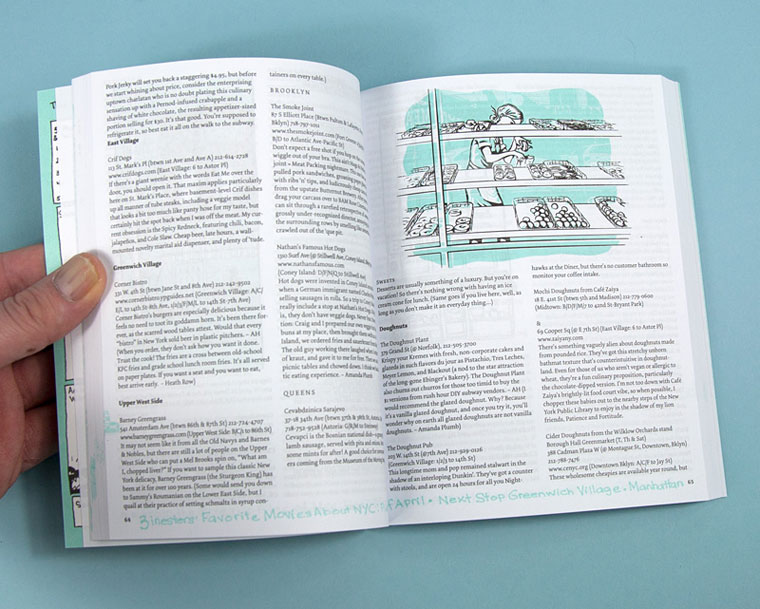 Ayun Halliday: Zinester’s Guide to NYC: The Last Wholly Analog Guide to NYC (Microcosm, 11/1/10)
Ayun Halliday: Zinester’s Guide to NYC: The Last Wholly Analog Guide to NYC (Microcosm, 11/1/10)
The Zinester’s Guide to NYC claims to be “the last wholly analog guide to NYC,” but more importantly, it’s a wonderful corrective to the Fodor’s and Frommer’s of the world. Chock-full of secret spots, advice, and things to see and do and eat, Zinester’s Guide is truly like having a best friend (or several dozen of them with competing viewpoints) show you around their native boroughs. Edited by Ayun Halliday (of East Village Inky fame) and created with comics, suggestions, and submissions from more than 50 other zine writers, Zinester’s Guide is an amazing amalgam of personal stories, rants and raves, and more.
Deeply familiar with where to go (and, more importantly, where not to), these natives know the city like no one else, as evidenced by a description of Art Bar in Greenwich Village: “This place is stellar. It’s not a scene bar. The wait staff is helpful and attentive. The back room, complete with fireplace, feels like someone’s basement. The Last Supper painting, featuring Jim Morrison as Jesus, is intriguing. – Heath Row.” This book truly seems like it would help the novitiate find places and things to do that they never would otherwise.
Pen doodles and comics proliferate throughout; some show what some places look like, but others are just pictures of people waiting for the subway, or a pigeon with a milkshake. It’s evident that a lot of love has gone into this guidebook, judging by the intricacy of the sketches of storefronts, pedestrians, and scenery.
Your guides and advisers mention the mundane and the wacky; they note where to score free food, or where to volunteer, or where to find a tenement museum or the best graffiti. One section is devoted to subway serenading, while elsewhere a list of wildlife includes pigeons, rats, and “wild parrots”: “Legend has it that in the 1960s, a shipment of Quaker parrots escaped from the tarmac at JFK (possibly because some mob guys jimmied open the crate looking for something else), and the ones squatting in the gothic spires of Greenwood Cemetery’s main entrance are their descendants.”

There are lists of free bathrooms, places to take a cheap date, good scenic views, free oatmeal, and photocopying places. In one terrific section, visitors are encouraged to make their own “hang your own pole art” using a template of a city traffic-sign pole printed on the page.
It goes above and beyond your expectations for a guidebook, with sections like “The Melissa Bastian Vegan 100!,” which lists the 100 best vegan dishes that Bastian has eaten in the city and where to find them, or “Getting Out of Airports” as general information, or a catalog of the grossest things that the writers have found in NYC (“half a squashed rat”). There are even suggestions for where to go in a heat wave (“the tenement museum, as a reminder to be glad that we no longer have to sleep on the fire escape to cool off on a hot night”) or a snowstorm (“not an airport, that’s for sure”). Other sections are resolutely tongue-in-cheek (“Royalty” lists everything from Lemon Ice King of Corona to Bruno the Ravioli King), while some are odd but useful (“Guest Bartending” – who knew?).
Zinester’s Guide includes some of the basics you’d find in any guidebook (where to eat, where to sleep, where to drink), but even then, few guides would suggest couch surfing or sublets, or even give a catalog of all the free newspapers in the city. No traditional guide seems likely to mention the “Grand Meeting of the Corduroy Appreciation Club,” which meets every 11/11 (the date that most looks like corduroy) at a bar in Brooklyn.
It tells of where to buy records, score the best vintage clothes, get a tattoo, find a black-and-white photo booth or pinball machine, work in a community garden, join a safari — the book just has everything. Its density can be overwhelming at first, especially considering that it’s a slim volume, but its logic quickly becomes evident.
By aiming to give the visitor a fuller description than any other guidebook, and almost entirely avoiding the tourist experience, the Zinester’s Guide encourages exploration and discovery and shows you a much better time than the AAA. It’s egalitarian in the sense that it opens the city up to tourists and natives, and offers the best spots to both.

